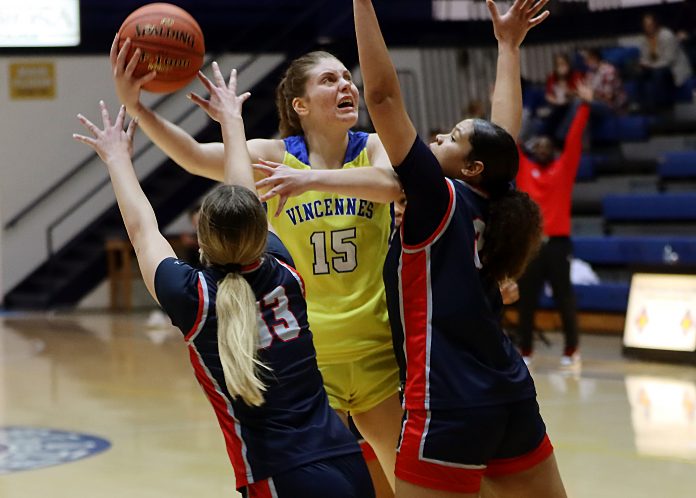| INDOT Seeking Public Comment on the Statewide Transportation Improvement Program (STIP) Amendment
Please review the proposed amendments to INDOT’s STIP which will add the FY24 Tribal TIP with four projects using Tribal Transportation Program funding for 2024-2027 here. To access the project list, scroll to the bottom of the page and find the link under the heading “Draft STIP Documents.” The link to the comment form is just below the amendment link. Check out this map to view current and future INDOT construction projects in your area of interest! The public comment period is open through Monday, December 23, 2024. Please share your comments by using this form, emailing to draftstip@indot.in.gov, or mailing to: |
| What is the STIP?
The State Transportation Improvement Program (STIP) is Indiana’s four planning and construction document that lists all projects, and project phases, expected to be funded within 5 years with federal funds as well as state-funded projects that has been deemed Regionally Significant. It is prepared in cooperation with local government entities throughout Indiana, including Transportation Planning Regions (TPRs), Metropolitan Planning Organizations (MPOs), and Regional Planning Organizations (RPOs). The STIP identifies the funding and the scheduling of transportation projects and programs by fiscal year (July 1 through June 30). It includes all state and local transportation projects funded with federal highway and/or federal transit funding along with 100 percent state funded transportation projects (including highway, passenger rail, freight, public transit, bicycle and pedestrian, and projects in the national parks). The STIP is the culmination of INDOT’s and the MPO’s planning processes and translates the objectives set forth in INDOT’s long-range transportation plans, the Transportation Asset Management Plan (TAMP) and Strategic Asset Management Plan (SAMP), asset lifecycle strategies, and Asset Teams’ business rules into committed projects for the upcoming four-year period. Why is it being amended? Periodically, changes are made to a project’s scope, cost and year of proposed construction. Changes are made with either amendment or an administrative modification to the STIP.
What is an Administrative Modification? Minor changes to the STIP can be made with an Administrative Modification. Examples are:
Administrative modifications are not required to be presented for public comment and are not approved by FHWA and FTA. Why is this Important? The STIP must be fiscally constrained. Only projects for which construction and operating funds are available are included. If a project is not included in a STIP, it is not eligible to receive federal funding. |
INDOT Seeking Public Comment on the Statewide Transportation Improvement Program (STIP) Amendment
EPD DAILY ACTIVITY REPORT
FOOTNOTE: EPD DAILY ACTIVITY REPORT information was provided by the EPD and posted by the City-County-County Observer without opinion, bias, or editing.
UE women’s basketball earns win over IU Columbus on Education Day
THUNDERBOLTS HOST RAIL YARD DAWGS THIS FRIDAY
- Peoria Rivermen:
- Record: 12-3-2, 26 Points, 2nd Place
- Leading Goal Scorer: Alec Baer (11 Goals)
- Leading Point Scorer: Alec Baer (19 Points)
- Primary Goaltender: Colby Muise (11-2-1, .930 Save %)
- Thunderbolts Record vs PEO: 1-2-1
- Roanoke Rail Yard Dawgs:
- Record: 9-5-1, 19 Points, T-5th Place
- Leading Goal Scorer: Gustav Muller (8 Goals)
- Leading Point Scorer: Nick Ford (24 Points)
- Primary Goaltender: Austyn Roudebush (9-4-1, .900 Save %)
- Thunderbolts 23-24 Record vs RNK: 2-2
- Knoxville Ice Bears:
- Record: 9-8-1, 19 Points, T-5th Place
- Leading Goal Scorer: Mitch Atkins (7 Goals)
- Leading Point Scorer: Mitch Atkins (15 Points)
- Primary Goaltender: Stephen Mundinger (7-6-0, .907 Save %)
- Thunderbolts Record vs KNX: 0-2-2
Lady Blazers drop final game before Holiday break to D-II No. 23 Jefferson College
Lady Blazers drop final game before Holiday break to D-II No. 23 Jefferson College
VINCENNES, Ind. – The Vincennes University Lady Trailblazers closed out the 2024 portion of their schedule Tuesday night inside the Physical Education Complex.
The Blazers faced another tough game, this time against NJCAA Division II No. 23 ranked Jefferson College from Hillsboro, Mo.
The Lady Blazers fought hard all night but came out on the wrong end of a 71-60 final score to the Lady Vikings.
VU got off to a good start Tuesday night, opening the game quickly offensively and taking an early 12-6 lead.
Jefferson College would respond back strong with an 11-2 scoring run to take their first lead of the night at 17-14.
The two teams traded baskets the rest of the first quarter with the Lady Vikings holding a narrow 22-20 lead over VU after the first 10 minutes of play.
Jefferson would add on to this early momentum in the second quarter, opening the second period with seven straight points before VU answered back with six straight to cut the deficit to 29-26.
Vincennes would get back within two of the Lady Vikings at 36-34 before Jefferson College scored the final basket of the first half to head into the locker room break leading Vincennes 38-34.
The game remained tight early in the third quarter with VU still playing from behind 50-46 before the Lady Vikings caught fire from three-point range to expand the lead to 63-48 heading into the fourth quarter.
The Lady Blazers stepped up their game defensively in the fourth quarter but were unable to capitalize on the offensive end as Jefferson College closed out the victory over VU 71-60.
VU was led offensively by freshman Emani Washington (Indianapolis, Ind.) who finished with 16 points, five rebounds, four assists and three steals.
Freshman Jazmyn Robey (Sellersburg, Ind.) was the next leading scorer for the Lady Blazers, finishing her night with 11 points and eight rebounds.
Freshman Delora Pricop (Satu Mare, Romania) just missed out on another double-double, finishing the game with 10 points and nine rebounds, while freshman Yanni Huggins was the fourth VU scorer in double figures with 10 points, six rebounds and three steals.
Freshman Ahmya Thomas (Phoenix, Ariz) finished her night with nine points and a team-high five steals, while sophomore Marta Gutierrez (Alicante, Spain) came off the bench to grab seven rebounds and dish out a team-high five assists.
The Lady Blazers head into the Holiday break with a record of 6-8 on the season, with a 2-0 record in Region 24 play.
Vincennes will return to the floor in 2025 with the Lady Blazers playing host to Volunteer State Community College from Gallatin, Tenn. Saturday, Jan. 4 inside the P.E. Complex. Tip-off time for that game is set for 5 p.m. eastern.
VINCENNES BOX SCORE
VINCENNES (60): Delora Pricop 4-11 0-0 10, Ahmya Thomas 4-16 0-2 9, Jazmyn Robey 4-9 2-2 11, Yanni Huggins 5-8 0-2 10, Emani Washington 5-15 3-4 16, Iris Comesana 1-3 0-0 2, Marta Gutierrez 1-6 0-22, Team 24-68 5-12 60.
Jefferson College – 22 16 25 8 – 71
VU (6-8, 2-0) – 20 14 14 12 – 60
Three-point goals: VU 7 (Washington 3, Pricop 2, Thomas, Robey). Rebounds: VU 41 (Pricop 9). Assists: VU 16 (Gutierrez 5). Steals: VU 13 (Thomas 5). Blocked Shots: VU 2 (Robey, Huggins). Turnovers: VU 23. Personal Fouls: VU 15. Fouled out: Pricop.
-30-
The Vincennes University Lady Trailblazers fall to 6-8 on the season, while still holding a 2-0 record in Region 24 play.
HOY JOBS
|
|||||||||||||
|
|||||||||||||
|
|||||||||||||
|
|||||||||||||
|
|||||||||||||
|
|||||||||||||
|
|||||||||||||
|
|||||||||||||
|
|||||||||||||
|
|||||||||||||
|
|||||||||||||
|
|||||||||||||
|
|||||||||||||
|
|||||||||||||
|
|||||||||||||
|
Update on Condition of Serious Injuries to Off-Duty Police Officer
Last week, we shared the unfortunate news regarding an off-duty Evansville Police officer who was involved in a life-threatening vehicle accident in Warrick County. Officer Jordan Rundle, was a passenger in the vehicle that was struck.
Officer Rundle sustained serious injuries in the crash and, after receiving initial treatment locally, was transferred over the weekend to a specialized hospital in Nashville. His medical team is dedicated to providing the best possible treatment as he continues further care.
Officer Rundle’s wife, who was also in the vehicle at the time of the incident, has been released from the hospital following treatment for her injuries, and is at Officer Rundle’s side. The driver of the second vehicle involved in the crash suffered minor injuries.
Nashville Metro Police Department (NMPD) and the NMPD Fraternal Order of Police have been supportive of the Rundle family during their time in Nashville.
Officer Rundle began his service with the Evansville Police Department on July 15, 2024.
The Evansville Police Department, alongside its officers, staff and F.O.P Lodge 73, remains
steadfast in supporting Officer Rundle and his family throughout this challenging time. We are deeply appreciative of the outpouring of concern, prayers, and support from the community. This generosity has been a great source of comfort to Officer Rundle’s loved ones as they navigate these difficult circumstances.
Ways to support include:
• Donations can be made through Venmo at @elaniemay16.
• Apparel supporting Officer Rundle is available for purchase at the following link: Team Jordan Apparel
The Campaign-to-Nonprofit Pipeline: A Loophole in Election Fundraising?
The Campaign-to-Nonprofit Pipeline: A Loophole in Election Fundraising?
In the world of political campaigns, the trail doesn’t always end at the ballot box. While most people focus on the outcomes of elections, the financial mechanics behind them can continue to ripple long after the votes are counted. One such mechanism is the practice of transferring surplus campaign funds to nonprofit organizations. Though entirely legal, this process has sparked debate about ethical boundaries, especially when defeated candidates use these nonprofits as personal platforms, complete with lucrative salaries.
The Basics: Surplus Campaign Funds
Under federal and state election laws, candidates are not allowed to pocket surplus campaign funds for personal use. However, they are permitted to redirect these funds to a variety of outlets, including charitable organizations, political party committees, or even future campaigns. The option to donate to 501(c)(3) nonprofits—organizations exempt from federal income tax due to their charitable, religious, educational, or scientific purposes—is particularly popular.
Turning Campaign Losses into Nonprofit Leadership
A candidate who loses an election but ends up with substantial leftover funds has a unique opportunity: they can create a 501(c)(3) nonprofit, transfer campaign funds into it, and appoint themselves as CEO or a board member. This arrangement allows them to remain in public service or advocacy while drawing a salary. Such practices blur the line between public interest and personal gain, raising questions about the intent behind the formation of these nonprofits.
Critics argue this creates an ethical gray area, as it provides a pathway for candidates to indirectly benefit from campaign donations. The donors, who likely intended to support a political campaign, may not have anticipated their contributions funding an organization run by the very candidate they backed—or opposed.
Examples of the Practice
Cynthia McKinney (Georgia): The former U.S. Representative redirected some of her campaign funds to support advocacy work after losing her seat in 2006. While her nonprofit, focused on public policy and education, was within the bounds of the law, the optics of such arrangements have been questioned by critics who argue for greater transparency.
Alan Grayson (Florida): Known for his progressive stances, Grayson funneled leftover campaign funds into organizations promoting similar causes. Though he did not personally lead the nonprofits, his involvement raised eyebrows about the intersection of political and charitable efforts.
Mike Gravel (Alaska): Gravel, a former U.S. Senator and presidential candidate, established nonprofits focused on direct democracy. While not directly drawing a salary, his affiliation highlighted how surplus campaign funds can seed initiatives aligned with a candidate’s political philosophy.
The Ethical Debate
Proponents of this practice argue that it provides a meaningful way for candidates to continue contributing to society. By forming nonprofits, candidates can channel campaign resources into causes they are passionate about, such as education, healthcare, or social justice. For example, a candidate who campaigned on environmental issues might create a nonprofit to combat climate change, ensuring their platform has a lasting impact.
However, critics contend that these practices can erode public trust. Donors may feel misled if their contributions end up funding a candidate’s post-campaign salary. Furthermore, some question whether these nonprofits serve their stated missions or merely function as a means for defeated candidates to maintain relevance and financial stability.
Calls for Reform
The campaign-to-nonprofit pipeline has prompted calls for greater oversight. Some suggest stricter rules for the use of surplus campaign funds, such as requiring donor consent for transfers to nonprofits or limiting candidates’ ability to hold paid positions within these organizations. Others advocate for complete transparency, mandating detailed reporting on how these funds are used and the roles of former candidates in the nonprofits they establish.
Conclusion
While transferring campaign funds to nonprofits is a legal and often constructive practice, it raises legitimate concerns about ethics and transparency. As more candidates explore this avenue, public scrutiny is likely to increase. Balancing the legal use of surplus funds with the public’s expectation of integrity will be essential for maintaining trust in the political process. Whether reform is on the horizon remains to be seen, but the debate underscores the importance of accountability in how campaign dollars are spent—even after the campaign ends.











